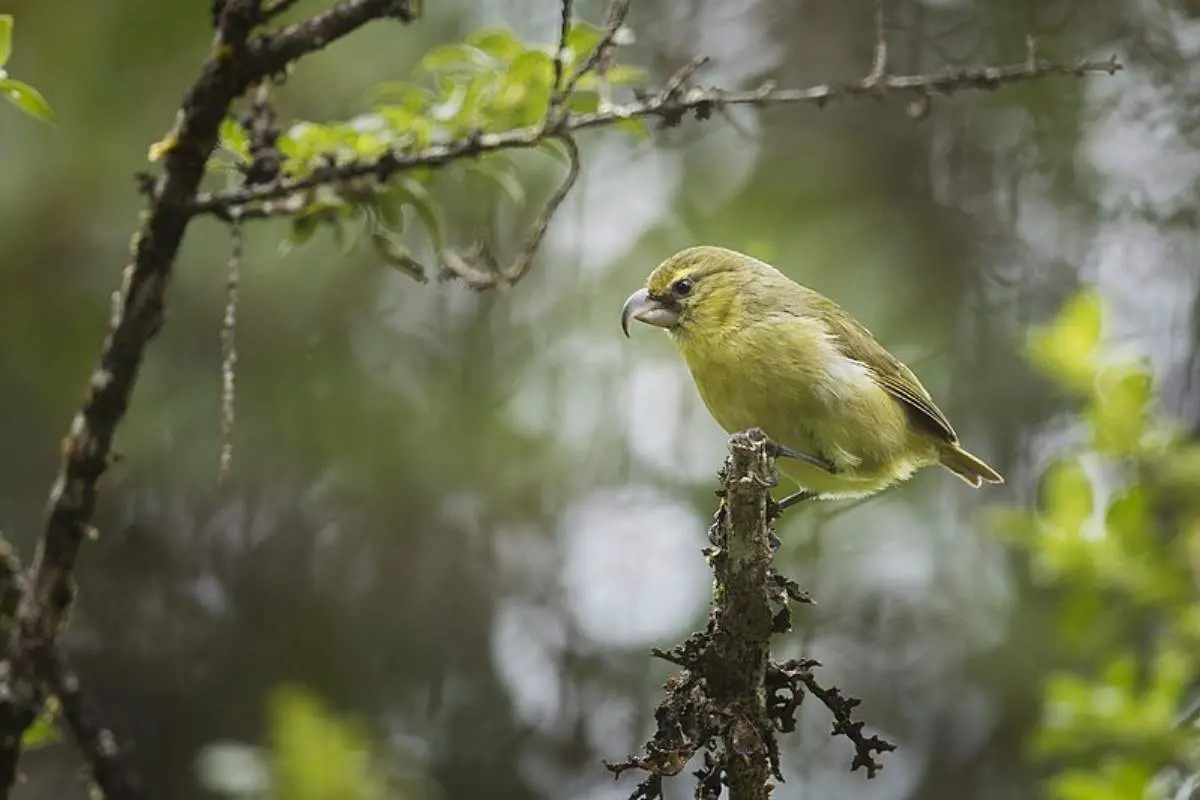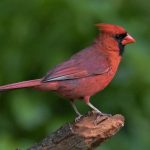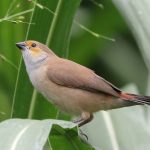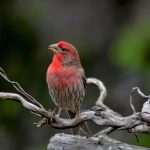Maui parrotbill | image by Zach Pezzillo, Maui Forest Bird Recovery Project via Wikimedia Commons | CC BY-SA 4.0
Common Name: Maui Parrotbill
Scientific Name: Pseudonestor xanthophrys| Size | Diet | Range in Hawaii | Status in Hawaii |
|---|---|---|---|
| 5 ½ in. | insectivorous diet | island of Maui in Hawaii | critically endangered |
The Maui Parrotbill (Pseudonestor xanthophrys) is a small, critically endangered bird found only on the Hawaiian island of Maui. It is a member of the Hawaiian honeycreeper family, which consists of a diverse group of birds that evolved to fill a variety of niches on the islands.
Maui Parrotbill
Appearance

The Maui Parrotbill is a small, brightly colored bird with a distinctive appearance. It has a round head, a short, slightly curved bill, and a long, slightly forked tail. The male and female are similar in size and appearance, with the male being slightly larger.
It has a mostly olive-green upper body, with a yellow breast and belly. Its wings and tail are dark brown, with white bars on the wings. The male has a reddish patch on the back of its head, while the female has a pale yellow patch.
The Maui Parrotbill has a distinctive, high-pitched call that is often heard in the forest. In general, the Maui Parrotbill is a small, compact bird with a bright, colorful appearance. It is an important cultural symbol for the people of Hawaii and is revered for its beauty and unique characteristics.
Diet
The Maui Parrotbill is a nectarivore, feeding primarily on the nectar of native Hawaiian plants. It is also known to feed on insects and fruit.
Maui Parrotbills are important pollinators of native Hawaiian plants and play a vital role in the ecosystem. They are also an important cultural symbol for the people of Hawaii and are revered for their beauty and unique characteristics.
Behavior
The Maui Parrotbill is a non-migratory, territorial bird that is usually found in pairs or small groups. It is active during the day and tends to forage in the canopy of native Hawaiian plants.
The Maui Parrotbill has a distinctive, high-pitched call that is often heard in the forest. It is a vocal bird that uses a variety of calls to communicate with its mate and defend its territory.
Nesting
Maui Parrotbills typically nest in trees or shrubs, building a cup-shaped nest made of twigs and lined with plant fibers or feathers. The female lays a single egg, which is incubated by both parents for about two weeks. The chick is fed by both parents and fledges (leaves the nest) after about three weeks.
Maui Parrotbills are monogamous and mate for life, with both the male and female participating in nest building and chick rearing. The male often brings materials to the female, who does most of the construction.
The nest is usually located in a fork of a tree or shrub and is well-concealed by foliage. Nesting is an important reproductive event for the Maui Parrotbill, but it is also a vulnerable time for the birds.
Habitat
The Maui Parrotbill is found in a variety of habitats, including montane wet and dry forests, shrublands, and grasslands. It is typically found at elevations between 500 and 2,500 feet (150-750 meters) above sea level.
Range
The Maui Parrotbill is found only on the Hawaiian island of Maui. It is a non-migratory bird that is restricted to a small range in the eastern and central parts of the island.
Conservation Status
The Maui Parrotbill is one of the most endangered birds in the world, with an estimated population of fewer than 500 individuals. It is threatened by habitat loss, disease, and introduced predators, and is classified as critically endangered by the International Union for Conservation of Nature (IUCN).
Conservation efforts are underway to protect the Maui Parrotbill and its habitat, including habitat restoration, disease control, and predator management.
Interesting Facts
1. They feed on insects and nectar
The Maui Parrotbill feeds on insects and nectar, and it has a unique feeding behavior called “gaping.” This involves using its sharp, curved bill to pry open the base of flowers in order to reach the nectar inside.
2. They are an important cultural species for the native Hawaiian people
The Maui Parrotbill is considered a “aumakua,” or guardian spirit, and it is believed to bring good fortune to those who see it.
3. They are endangered species
Maui Parrotbill is listed as critically endangered by the International Union for Conservation of Nature (IUCN), and there are estimated to be fewer than 1,000 individuals remaining in the wild.
4. They can only found in the high-elevation rainforests of the East Maui Mountains
Maui Parrotbill prefers habitats with thick undergrowth and dense vegetation, and it is often found foraging for food in the understory of these forests.
Frequently Asked Questions
What does the Maui Parrotbill look like?
The Maui Parrotbill is a small bird, measuring about 5 ½ inches in length and weighing around 0.5 ounces. It has a distinctive appearance, with a short, curved bill and a yellow head and breast. It also has a green back, wings, and tail.
Is the Maui Parrotbill an important pollinator?
Yes, the Maui Parrotbill is an important pollinator in its native habitat. It is known to visit a wide variety of flowering plants, including native species such as ohia and native hibiscus.




